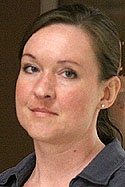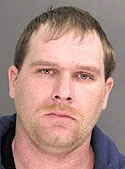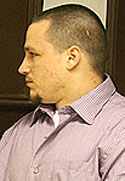![]()

For your convenience, we have installed the link below to make donations to this website easier. Now you can utilize your PayPal account or your credit card.
--------------

Click on the logo above to visit the website for Cornell Cooperative Extension of Schuyler County

It
all came down to the texts![]()
Juror says timeline showed conspiracy
WATKINS GLEN, May 9 -- The jurors in the Alice Trappler murder trial started out with an 8-4 split in favor of conviction, and by the end of the first day of deliberations, the vote was 11-1.
The next morning, the one holdout for acquittal was convinced that Trappler had taken part in a conspiracy, which meant she had to be guilty of all the charges against her -- murder and burglary as well as conspiracy, since they were all interconnected in the killing of Daniel Bennett, Trappler's former lover and the father of her daughter, Lily. A half-hour after the start of the second day of deliberations, Judge Dennis Morris was notified that a verdict was at hand.
One juror, who asked to remain anonymous, described the experience at the trial, how Trappler's guilt was decided, and the aftermath.
The post-trial experience, in fact, featured a welcome coincidence. The jurors, though it was just 10:30 a.m. and Bleachers tavern on Franklin Street was not yet open, went there, knocked on the back door, and asked: "Can you open for some jurors?" Bleachers did.
A short time later, District Attorney Joe Fazzary and several state police investigators involved in the murder case arrived by chance at the same locale.
 "It
was interesting, finally being able to discuss the case and with
the state police," said the juror. And it was a case with plenty
to talk about.
"It
was interesting, finally being able to discuss the case and with
the state police," said the juror. And it was a case with plenty
to talk about.
For instance, the jury was not sold on Trappler's guilt through Nathan Hand's testimony, nor through Fazzary's closing argument, nor through any particular piece of evidence presented at the trial. It was sold through a study of text messages and Verizon and AT&T records that enabled the jurors to create a timeline of calls between Trappler and alleged killer Thomas Borden, her ex-husband.
Fazzary's closing "was a fine presentation," the juror said, "but it didn't affect our decision. More than anything, I don't think (defense attorney Susan BetzJitomir) had a case. Her witnesses were mostly character witnesses; they didn't have a lot to say."
BetzJitomir's closing argument didn't help her either, he added. The defense counsel, suffering from illness, seemed to wander, taking an hour and 45 minutes, roughly 45 minutes longer than she promised. And, said the juror, "she wasn't as eloquent as Joe."
There was the matter, too, of Trappler's close attention to the proceedings and her propensity to take notes and confer with BetzJitomir on how to question Fazzary witnesses on cross-examination. Various members of the jury were watching her, and one asked during deliberations, "Okay, who was the attorney out there?"
"I don't know," the juror said, "if it's normal for a defendant to participate that deeply."
The jury was "leaning toward guilty fairly early," he said. "It came down to whether Trappler actively participated in the planning or manipulated people to do it" -- to commit a crime at the Bennett residence. The question was "what did she do to cause this to happen, and when did she cause it. That was the hard part."
 The
jury had bonded over the weeks of the trial, the juror said. "We
got to be pretty good buds." And when it came time to deliberate,
"we were pretty unanimous after the first hour." At first "four
of us, myself included, needed to be shown that Alice and Wes (Borden,
her ex-husband) and the gun were together." The gun was the murder
weapon, a sawed-off .12 gauge Mossberg shotgun given to Trappler by a
lover, Brett Bacon.
The
jury had bonded over the weeks of the trial, the juror said. "We
got to be pretty good buds." And when it came time to deliberate,
"we were pretty unanimous after the first hour." At first "four
of us, myself included, needed to be shown that Alice and Wes (Borden,
her ex-husband) and the gun were together." The gun was the murder
weapon, a sawed-off .12 gauge Mossberg shotgun given to Trappler by a
lover, Brett Bacon.
By reviewing AT&T and Verizon logs -- "We spent most of our hours of deliberation going over those" -- the jurors "put the file, Wes and Alice in roughly the same place at the same time. The evidence was on the text messages." The file he referred to was purchased by Borden on the day of the killing -- to be used, investigators have indicated, to rub off the serial number on the murder weapon.
The jury, by poring over and arranging Borden-Trappler calls and texts -- cross-referencing and organizing them chronologically -- discovered that not long after the file purchase, Borden texted Trappler to say "I'm here." The location of "here," the juror said, was determined through GPS coordinates to be "in the same vicinity as Alice," which is to say at her mother's house. The jury decided that Alice was there, too -- a determination made through tower records that recorded pings from her phone.
"Wes and the file were at her mother's house. I don't know if she witnessed him do it," but it was likely, the juror said, that Borden used the file to erase the serial number on the gun while there at that house. "Forty minutes after that, he bought bullets, four hours before the murder." After buying the bullets, said the juror, Borden picked up Hand, who thought they were going to beat up Daniel Bennett. But according to Hand's testimony, Borden had murder on his mind.
So Trappler and Borden "were in the same vicinity" after the file purchase and before the bullets were purchased, the juror said, adding: "We made a leap of faith that the box, the magic box" often mentioned in testimony -- one which Borden told Trappler to throw away, but which she said was a box that held a baby's toy bowl for her daughter Lily -- "had to be the file box."
 "Another
thing," said the juror. "Earlier that day, at 6 a.m., Wes texted
Alice that he was 'sitting outside now.' He was outside Bennett's house,
scoping the place out that early." That was inferred, the juror explained,
from "an ensuing text message exchange" between Borden and Trappler.
"Another
thing," said the juror. "Earlier that day, at 6 a.m., Wes texted
Alice that he was 'sitting outside now.' He was outside Bennett's house,
scoping the place out that early." That was inferred, the juror explained,
from "an ensuing text message exchange" between Borden and Trappler.
The jurors disregarded the testimony of Hand, originally charged with 2nd Degree Murder but facing a reduced count of 1st Degree Manslaughter now in return for having taken the stand against Trappler. "We thought he was sincere in his emotions," the juror said, "but we thought he was lying, too. What he was saying just sounded a little too neat."
Trappler's decision to take the stand, he added, was a poor one. "Several members of the jury -- and me in particular -- felt she was being evasive or lying. She was having a difficult time telling the truth. It would have been better (for her) if she hadn't taken the stand. It's not what convicted her, but it didn't help."
He said Fazzary, with his aggressive, bulldog style, "was beating her up (verbally) a little too much. At least that's what I thought. But it wasn't discussed by the jury," which was more focused on finding a link -- such as the file, Wes and Alice together in one locale -- that could compel them to act on the belief that "Alice was manipulating the whole thing from the beginning. She had a dozen people participating in this thing," though only three, including herself, were doing so knowingly within the framework of a criminal conspiracy.
She and Borden "were texting from 6 a.m. to 9:40ish" at night on the day of the murder, he said, and "there was too much innuendo and code" in the messages. "It kind of matched her conversations in jail" -- phone calls to her mother in which she said she needed badly to talk to lover Brett Bacon, who had given her the shotgun that became the murder weapon. "She referred to him as something like 'that party' and 'talk to that person,'" the juror said.
The entire experience, he added, was "interesting and gratifying," and it "was phenomenal to see how the legal system works."
He said the jury was extremely attentive to everything going on -- to the testimony, to the items entered in evidence and, during lulls, to who was in the spectator section of the courtroom. "We could tell you who was wearing what," he said.
Being a juror was, overall, "harder work than I thought, but all of us took it seriously" -- including the four alternates, who had to be present for all of the testimony but couldn't participate in the deliberations. They were taken to another room in the same building, the County Building, while the jury worked toward a verdict.
The juror said he was sure the alternates were "frustrated" at their exclusion, but in talking to them afterwards it was clear "they came down the same line as the rest of us. They were genuinely in agreement with the ultimate verdicts."
Photos in text:
From top: Alice Trappler, Thomas Wesley Borden and Nathan Hand.
The Story from Day 1 may be found by clicking here.
The Story from Day 2 may be found by clicking here.
The Story from Day 3 may be found by clicking here.
The Story from Day 4 may be found by clicking here.
The Story from Day 5 may be found by clicking here.
The Story from Day 6 may be found by clicking here.
The Story from Day 7 may be found by clicking here.
The Story from Day 8 may be found by clicking here.
The Story from Day 9 may be found by clicking here.
The Story from Day 10 may be found by clicking here.
The Story from Day 11 may be found by clicking here.
The Story from Day 12 may be found by clicking here.
The Story from Day 13 may be found by clicking here.
The Story from Day 15 may be found by clicking here.
(All court stories by Charlie Haeffner)
Charles Haeffner
P.O. Box 365
Odessa, New York 14869
